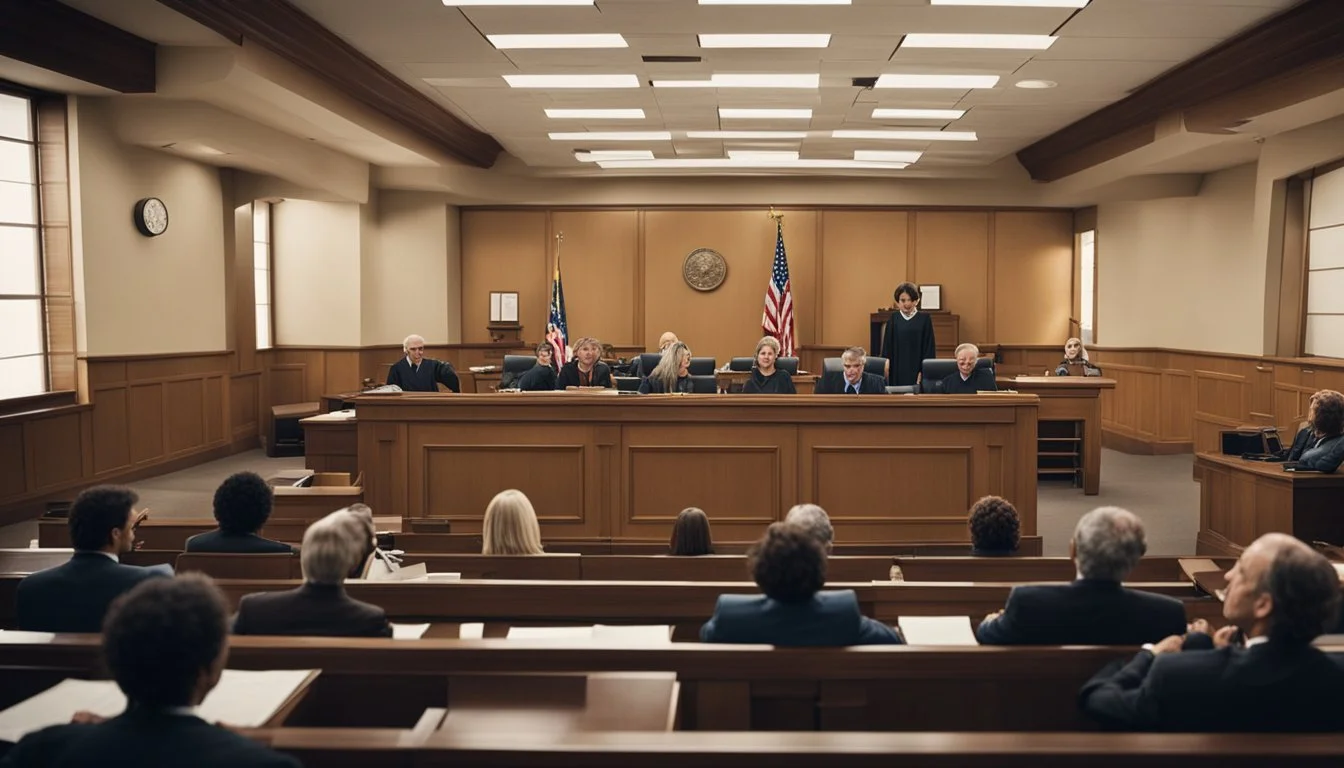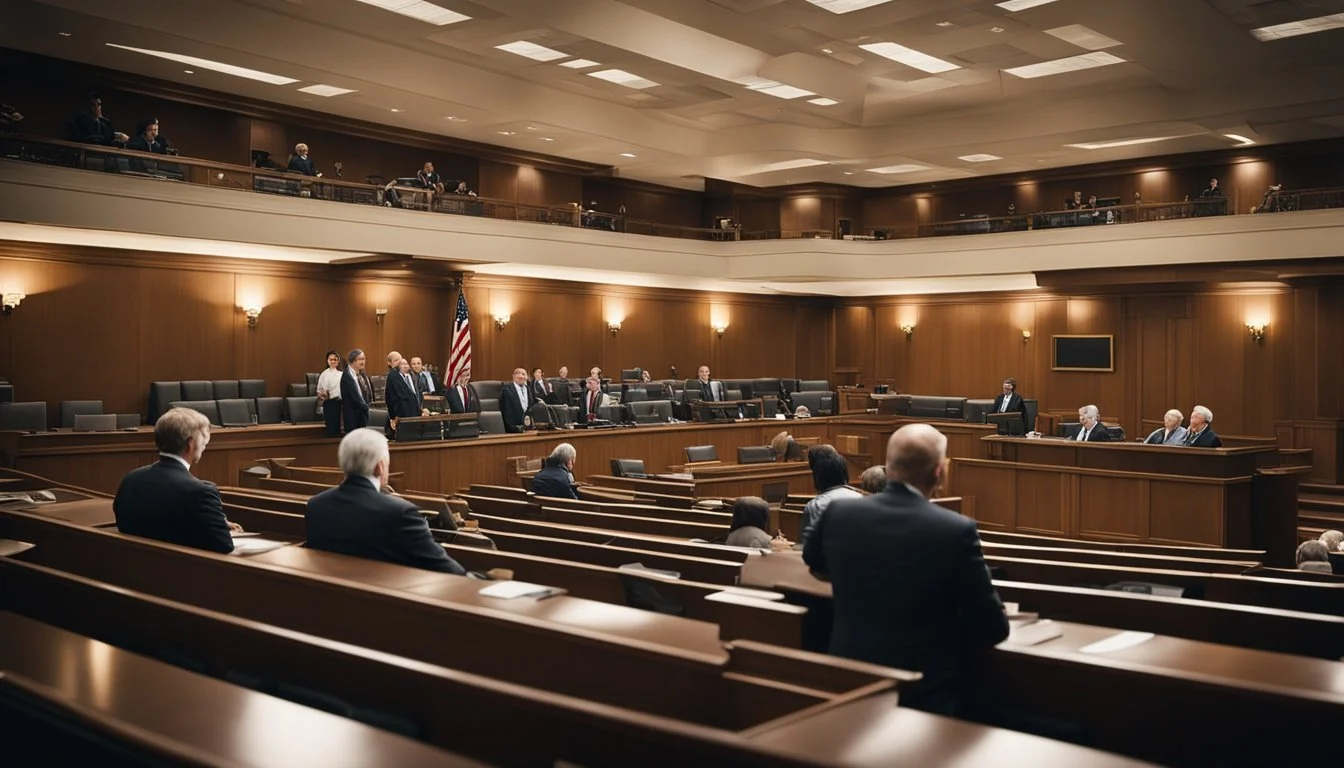Chilling Documentaries Reveal Ted Bundy's Reign of Terror
Ted Bundy's shocking crimes and trials captivated the public during the 1970s and 1980s. His reign of terror left a lasting impact on American society and the criminal justice system. Numerous documentaries have since explored Bundy's life, crimes, and the investigations that led to his capture, offering viewers insights into one of the most infamous serial killers in U.S. history.
These documentaries draw on interviews, archival footage, and expert analysis to piece together the complex puzzle of Bundy's psyche and actions. They examine his childhood, relationships, and the methods he used to evade law enforcement for years. Many also delve into the legal proceedings that ultimately resulted in Bundy's conviction and execution, shedding light on a dark chapter of American criminal history.
1) Conversations with a Killer: The Ted Bundy Tapes (2019)
"Conversations with a Killer: The Ted Bundy Tapes" is a four-part documentary series that premiered on Netflix in 2019. Created and directed by Joe Berlinger, the series offers a chilling glimpse into the mind of notorious serial killer Ted Bundy.
The documentary draws from over 100 hours of death row interviews with Bundy himself. These recordings form the backbone of the series, allowing viewers to hear Bundy's thoughts and perspectives in his own words.
Alongside the audio tapes, the series incorporates archival footage and present-day interviews. This blend of materials provides a comprehensive look at Bundy's life, crimes, and the impact he had on American society.
The episodes range from 51 to 74 minutes in length, exploring different aspects of Bundy's case. The series delves into his psychology, his crimes, and the media frenzy surrounding his trials.
"Conversations with a Killer" was released on January 24, 2019, coinciding with the 30th anniversary of Bundy's execution. It offers a searing portrait of one of America's most infamous serial killers.
2) Ted Bundy: Falling for a Killer (2020)
Ted Bundy: Falling for a Killer is a five-part docuseries that premiered on Amazon Prime Video in January 2020. The series offers a unique perspective on the infamous serial killer Ted Bundy.
The documentary focuses on the experiences of Elizabeth Kendall, Bundy's long-term girlfriend, and her daughter Molly. After nearly four decades of silence, they share their stories and provide new insights into Bundy's life and crimes.
The series explores how Bundy's hatred of women intersected with the feminist movement and culture wars of the 1970s. It reframes Bundy's crimes from a female perspective, shedding light on the impact his actions had on the women in his life.
Survivors of Bundy's attacks also contribute their accounts, adding depth to the narrative. The docuseries examines the societal context of Bundy's crimes and their lasting effects on those involved.
Ted Bundy: Falling for a Killer offers a fresh take on a well-known true crime story. It provides viewers with a deeper understanding of Bundy's relationships and the women affected by his actions.
3) Extremely Wicked, Shockingly Evil and Vile (2019)
Extremely Wicked, Shockingly Evil and Vile is a biographical crime drama film that explores Ted Bundy's life and crimes. Directed by Joe Berlinger, the movie stars Zac Efron as Bundy and Lily Collins as his longtime girlfriend, Elizabeth Kendall.
The film is based on Kendall's memoir, "The Phantom Prince: My Life with Ted Bundy." It presents a unique perspective on the infamous serial killer, focusing on his relationship with Kendall and her struggle to accept the truth about his heinous acts.
Set against the backdrop of the 1970s and 1980s, the movie chronicles Bundy's crimes, arrests, and trials. It showcases his charismatic persona and the manipulation tactics he employed to maintain his innocence.
The title of the film comes from the judge's description of Bundy during his sentencing. It aptly captures the shocking nature of his crimes and the contrast between his public image and his true nature.
4) The Ted Bundy Files
"The Ted Bundy Files" is a comprehensive documentary series that explores the life and crimes of notorious serial killer Ted Bundy. Released in 2020, this series offers a detailed look into Bundy's psychology and the impact of his actions on his victims and their families.
The documentary features extensive interviews with law enforcement officials, survivors, and those close to Bundy. It presents a chronological account of his crimes, arrest, trials, and eventual execution.
One of the most compelling aspects of "The Ted Bundy Files" is its use of archival footage and previously unreleased audio recordings. These elements provide viewers with a chilling glimpse into Bundy's mindset and his ability to manipulate those around him.
The series also examines the cultural impact of Bundy's case, exploring how it changed public perception of serial killers and influenced criminal profiling techniques. It offers a balanced perspective, avoiding sensationalism while still conveying the gravity of Bundy's crimes.
More information on "The Ted Bundy Files" (2020)
5) Ted Bundy: Mind of a Monster (2019)
"Ted Bundy: Mind of a Monster" is a documentary that offers a chilling exploration of one of America's most notorious serial killers. The film features exclusive interviews with friends and family members of Bundy's victims, providing unique perspectives on the impact of his crimes.
The documentary uses rare audio archives of Bundy himself, allowing viewers to hear his own words. These recordings offer disturbing insights into his thought processes and motivations.
Directed by Chris Holt and Tom Brisley, the film delves into Bundy's campaign of terror across the United States. It examines how he used his charisma and good looks to lure unsuspecting victims.
The documentary also covers Bundy's capture, trials, and eventual execution. It highlights the contrast between his outward appearance as a charming, educated man and the brutal reality of his actions.
"Mind of a Monster" is part of a larger series exploring infamous serial killers. It aims to provide a comprehensive look at Bundy's life and crimes, shedding new light on this dark chapter in criminal history.
6) Ted Bundy: American Boogeyman
Ted Bundy: American Boogeyman (2021) is a dramatized portrayal of the notorious serial killer's crimes and the ensuing manhunt. The film stars Chad Michael Murray as Ted Bundy, focusing on his murderous activities in the 1970s.
The movie depicts Bundy's pattern of targeting young women under 25 years old. It showcases specific incidents, including abductions in Midvale, Utah and the murders of Janice Ann Ott and Denise Marie Naslund.
FBI agents Kathleen McChesney and Holland Roden play central roles in the investigation. The film highlights their efforts to track down Bundy in what became one of the largest manhunts in American history.
The narrative unfolds against the backdrop of 1970s America, portraying the era's gritty atmosphere. It aims to capture the tension and fear surrounding Bundy's killing spree.
While based on true events, the film takes a thriller approach to storytelling. It incorporates elements of horror, including jump scares and suspenseful music, to dramatize Bundy's crimes.
7) 42 Hours of Terror: The Hunt for Ted Bundy (2015)
This documentary offers a gripping account of the intensive manhunt for Ted Bundy. It focuses on the 42-hour period following Bundy's escape from custody in Colorado in 1977.
The film features interviews with key law enforcement officials involved in the search. It provides insight into the strategies and challenges faced by investigators as they raced to recapture the elusive killer.
Rare archival footage and crime scene photographs are used to recreate the tense atmosphere of the search. The documentary also explores how Bundy managed to evade capture for so long despite being a wanted fugitive.
Viewers gain a deeper understanding of Bundy's cunning nature and the dedication of the officers who pursued him. The film highlights the pressure felt by law enforcement to prevent further killings during Bundy's time on the run.
8) Ted Bundy: Serial Monster (2018)
"Ted Bundy: Serial Monster" is a six-part documentary series that aired on REELZ in 2018. The series examines the life and crimes of Ted Bundy, one of America's most notorious serial killers.
Each episode focuses on a different aspect of Bundy's story, from his early years to his final capture and execution. The series uses archival footage, interviews with experts, and dramatic reenactments to paint a comprehensive picture of Bundy's crimes.
The documentary explores Bundy's psychology and the factors that may have contributed to his violent behavior. It also delves into the investigation that ultimately led to his arrest and conviction.
"Ted Bundy: Serial Monster" provides a detailed look at Bundy's victims and the impact of his crimes on their families and communities. The series also examines Bundy's ability to manipulate the media and public perception during his trials.
9) Ted Bundy: The Death Row Confessions
Ted Bundy's final days on death row were marked by a series of confessions. As his execution date approached, Bundy admitted to numerous murders he had previously denied.
In 1989, Bundy spoke with investigators and psychologists, revealing details about his crimes. He confessed to approximately 30 murders, though the true number of victims remains unknown.
Bundy's death row confessions were partially motivated by a desire to delay his execution. He offered information about unsolved cases, hoping authorities would postpone his sentence to gather more evidence.
These last-minute revelations provided closure for some victims' families. However, they also raised questions about Bundy's motives and the full extent of his crimes.
Several documentaries have explored Bundy's death row confessions. "Conversations with a Killer: The Ted Bundy Tapes" (2019) features audio recordings of Bundy's final interviews, offering insight into his mindset.
"Ted Bundy: The Death Row Confessions" (2012) examines the serial killer's admissions and their impact on ongoing investigations. It delves into the psychology behind Bundy's decision to confess after years of denial.
10) I Survived Ted Bundy (2020)
"I Survived Ted Bundy" is a compelling documentary that focuses on the stories of women who escaped Bundy's murderous grasp. The film provides a unique perspective on the notorious serial killer by giving voice to his survivors.
The documentary features interviews with women who had close encounters with Bundy but managed to survive. These firsthand accounts offer chilling insights into his tactics and the terror he inflicted.
Kathy Kleiner Rubin, one of Bundy's survivors, shares her harrowing experience of being attacked in her sorority house. Her story highlights the long-lasting impact of such traumatic events on survivors' lives.
The film explores how these women's lives were forever changed by their encounters with Bundy. It delves into their ongoing struggles with PTSD and other psychological effects resulting from their ordeals.
By focusing on survivors rather than the killer, "I Survived Ted Bundy" offers a fresh perspective on a well-known true crime story. It serves as a testament to the resilience of those who lived to tell their tales.
More information about the documentary
Overview of Ted Bundy's Crimes
Ted Bundy was one of America's most notorious serial killers, active in the 1970s. He confessed to murdering 30 young women across several states, though the actual number of victims may be higher.
Timeline of Murders
Bundy's known killing spree began in 1969 in Washington state. His attacks escalated in 1974, with a series of abductions and murders in Washington and Oregon. In 1975, Bundy moved to Utah, continuing his crimes there and in Colorado.
He was arrested in 1975 but escaped twice in 1977. After his second escape, Bundy fled to Florida. There, he committed his final known murders in January 1978, including the brutal attack at a Florida State University sorority house.
Bundy was finally captured on February 15, 1978. His last victim was 12-year-old Kimberly Leach, whose murder led to Bundy's death sentence.
Victims and Locations
Bundy's victims were primarily young women and girls, often with long, dark hair parted in the middle. He targeted college campuses and recreation areas across seven states:
Washington
Oregon
Utah
Colorado
Idaho
California
Florida
Bundy used various methods to lure victims, including feigning injury or impersonating authority figures. He often took victims to secluded areas before assaulting and murdering them.
Many of Bundy's victims were never found. He sometimes revisited crime scenes to perform acts of necrophilia and took "trophies" from his victims, including jewelry and photographs.
Investigation and Capture
Ted Bundy's evasion of law enforcement spanned several years across multiple states. His capture involved intricate police work and crucial pieces of evidence that ultimately led to his downfall.
Police Efforts and Challenges
Law enforcement faced significant hurdles in tracking Bundy. His charisma and ability to blend in made him difficult to identify. Bundy often changed his appearance and used aliases to avoid detection.
Police relied on eyewitness accounts and composite sketches, but these proved unreliable at times. Bundy's mobility across state lines complicated jurisdictional issues, hampering coordination between agencies.
The formation of task forces in Washington, Utah, and Colorado helped pool resources and information. However, Bundy's cunning nature and law school background allowed him to stay one step ahead for years.
Key Evidence
Physical evidence played a crucial role in Bundy's eventual capture. A blood-stained crowbar found in his car linked him to an attack in Utah. Bite mark analysis from a victim in Florida provided damning forensic evidence.
Bundy's Volkswagen Beetle became a key piece of evidence. Witnesses reported seeing a similar vehicle near crime scenes. When searched, police found hair samples matching multiple victims.
Credit card receipts and gas station records helped track Bundy's movements. These paper trails placed him in the vicinity of several disappearances, strengthening the case against him.
Trials and Legal Proceedings
Ted Bundy faced multiple trials across different states for his heinous crimes. His legal proceedings garnered intense media attention and public fascination.
Early Trials
Bundy's first major trial began in February 1976 in Utah for the kidnapping of Carol DaRonch. He was convicted and sentenced to 1-15 years in prison. In October 1977, Bundy escaped custody in Colorado while facing murder charges. He was recaptured but escaped again in December, fleeing to Florida.
Florida Trials
Bundy's Florida trials commenced in June 1979 for the Chi Omega sorority murders. Despite acting as his own attorney, he was found guilty and sentenced to death. A second trial in January 1980 for the murder of Kimberly Leach also resulted in a guilty verdict and death sentence.
The Florida trials featured dramatic moments, including Bundy's marriage proposal to Carole Ann Boone while she testified on his behalf. Bundy's charm and intelligence were on full display as he cross-examined witnesses and delivered closing arguments.
Forensic evidence, including bite mark analysis, played a crucial role in securing convictions. The trials set legal precedents and highlighted the emerging field of criminal profiling.
Media Coverage and Public Reaction
Ted Bundy's case attracted intense media attention, shaping public perception and influencing the criminal justice process. The coverage ranged from sensationalized reports to in-depth analyses, leaving a lasting impact on how society viewed serial killers.
Role of Media in the Case
Television played a crucial role in the Bundy case. In 1978-1979, cameras were allowed in the courtroom, providing unprecedented access to Bundy's trial. This marked a significant shift in media coverage of high-profile criminal cases. Newspapers and magazines extensively reported on Bundy's crimes, arrests, and legal proceedings.
The media's focus on Bundy's charismatic personality and good looks created a complex narrative. Some outlets portrayed him as a charming, intelligent law student, contrasting sharply with the horrific nature of his crimes. This dichotomy fascinated the public and fueled ongoing interest in the case.
Impact on Public Perception
Media coverage significantly influenced public opinion about Bundy and serial killers in general. The extensive reporting heightened awareness of violent crimes against women and sparked discussions about personal safety.
The portrayal of Bundy as an educated, attractive man challenged societal assumptions about the appearance and background of violent criminals. This led to increased fear and suspicion, as people realized that dangerous individuals could blend seamlessly into society.
Public fascination with the case persisted long after Bundy's execution. Numerous books, documentaries, and films have been produced, examining various aspects of his crimes and psychology. This ongoing interest reflects the lasting impact of media coverage on public perception of serial killers.










